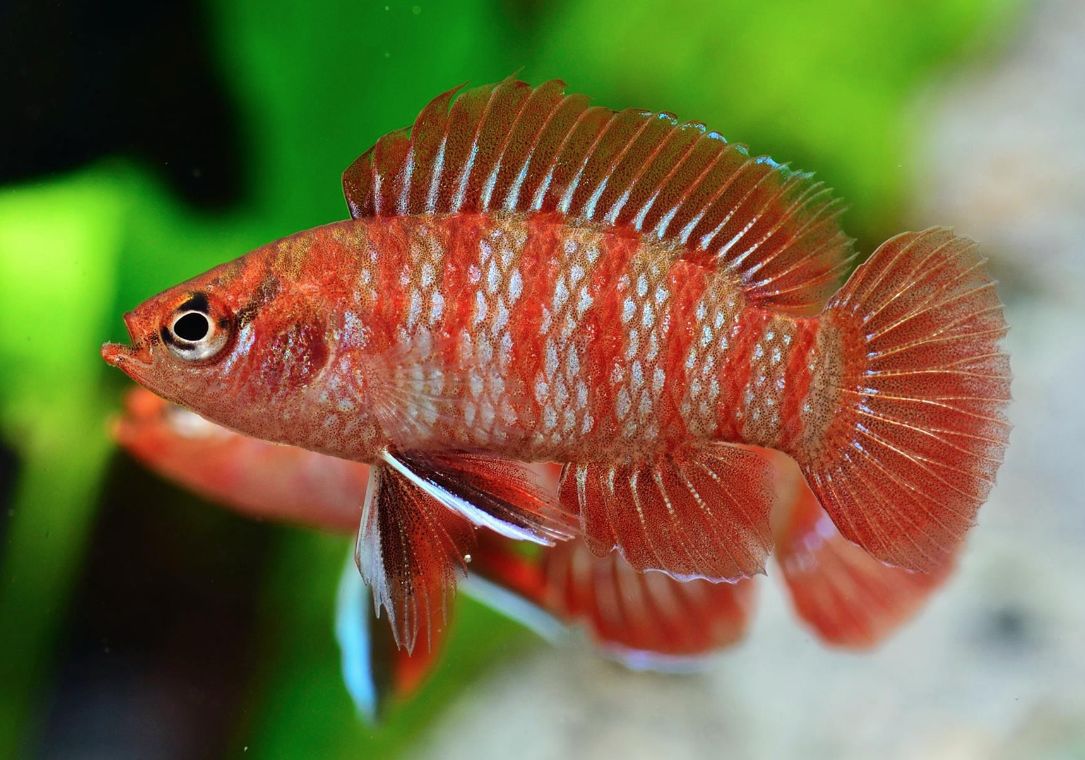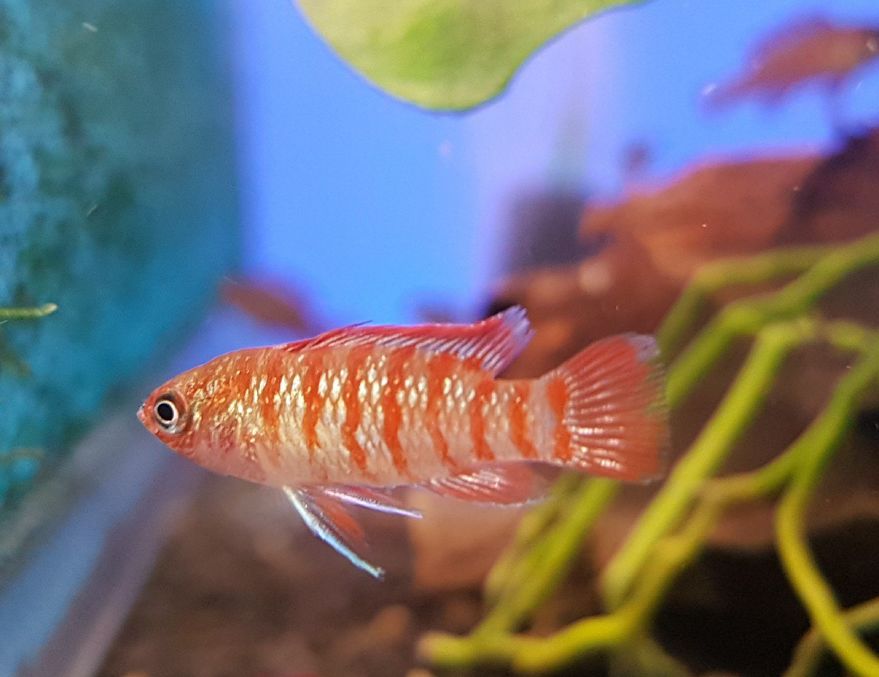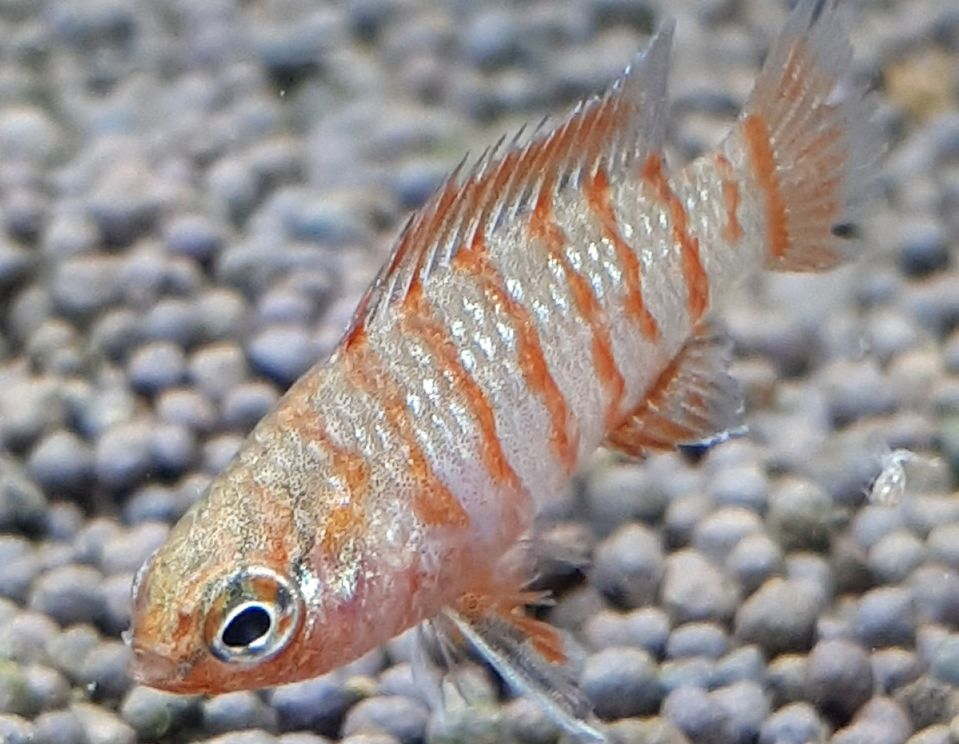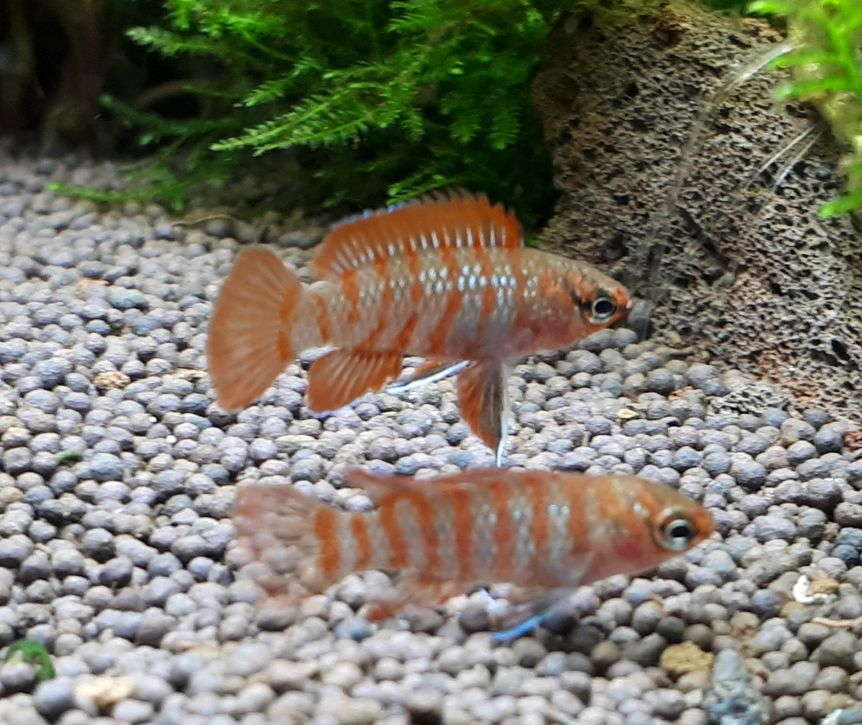Scarlet badis (Dario dario) is a small fish from Badidae family from India. This is the least known species from Perciformes kind. Further in the article, you’ll find out how to keep dario fish, feed it, select tank mates, and breed it.

Contents
Habitat in the wild
The scarlet badis, also known as Dario dario, belongs to the family Badidae. The Badidae family is a group of small freshwater fish native to South Asia, particularly found in the slow-moving waters of streams, swamps, and rice paddies. These fish are known for their striking colors and fascinating behaviors, making them popular choices among hobbyist aquarium keepers.
The scarlet badis (Dario dario) is native to the Indian subcontinent, specifically found in slow-moving waters, shallow streams, swamps, and rice paddies in India and Bangladesh. Dario dario inhabits in the basing of Brahmaputra river within Assam state area and in South of West Bengal state. The scarlet badis can be encountered in small rivers up to 1 m deep with crystal clear water and sandy or gravel bottom. It usually stays close to shores and swims among thick-set water plants. They are typically found in areas with dense aquatic vegetation, submerged roots, and leaf litter. Their natural habitat is characterized by slow-flowing or still waters with minimal current.
In the wild, Scarlet Badis prefer areas with low light conditions and plenty of hiding spots among plants and other structures. They are known to inhabit areas where the water is slightly acidic to neutral, with a pH range of around 6.0 to 7.0. The temperature of their native waters can range from approximately 22°C to 28°C (72°F to 82°F).

Description
Size
The Dario dario is a very small fish, typically reaching a maximum size of about 1 inch (approximately 2.5 centimeters) in length when fully grown. Due to their tiny size, they are sometimes referred to as “nano fish” in the aquarium hobby. Despite their small stature, they are known for their striking colors and interesting behaviors, which make them a popular choice among hobbyist aquarium keepers.
Lifespan
The lifespan of the scarlet badis can vary depending on various factors, including the quality of care, water conditions, and genetics. In their natural habitat, their lifespan is relatively short, typically around 1 to 2 years. However, in well-maintained aquariums with proper care, some individuals have been reported to live slightly longer, up to 2 to 3 years.
To maximize the lifespan of scarlet badis in captivity, it’s crucial to provide them with a suitable environment, including clean and stable water conditions, appropriate tank size, and a well-balanced diet. Regular water changes, a varied diet, and a stress-free environment can contribute to their overall health and potentially extend their lifespan.
Coloring
Dario dario head and back color varies from rusty orange to ruby-red. Its sides are covered with seven different stripes that continue on the fins as well. These stripes interchange with eight silvery-blue stripes that also stretch along the fins. Its abdominal fins become saturated bluish and white as well as all fins have bright white edges.
The scarlet badis females have simpler coloring. They are silvery-gray with transparent fins. Some large females have several thin pale-orange stripes on their body sides. Nevertheless, it is much harder to see the difference between the male and female when buying it in a pet shop.
Since the fish on sale in quite often young, they tend to have similar coloring and fins shape. Besides, many males, especially if they are at the bottom of the group hierarchy, have uniform gray coloring.
| Characteristic | Description |
|---|---|
| Scientific Name | Dario dario |
| Common Name | Scarlet Badis; badis fish; dario fish; scarlet fish |
| Family | Badidae |
| Native Range | India and Bangladesh |
| Maximum Size | Approximately 1 inch (2.5 cm) |
| Lifespan | 1 to 2 years (in captivity) |
| Temperature Range | 22°C to 28°C (72°F to 82°F) |
| Water pH | 6.0 to 7.0 (slightly acidic to neutral) |
| Tank Size | At least 10 gallons (approximately 38 liters) |
| Tank Setup | Well-planted with hiding spots |
| Behavior | Peaceful, shy, and territorial |
| Diet | Carnivorous – small live and frozen foods |
| Compatibility | Peaceful community fish, avoid aggressive ones |
| Water Conditions | Clean, well-filtered, and regular water changes |
| Breeding | Complex courtship behaviors |
| Special Considerations | Sensitive to water quality and parameters |

Difficulties in keeping
This is quite a demanding fish in terms of tank conditions. Despite its small size it can demonstrate aggression towards its tank mates. Scarlet badis doesn’t eat artificial food much, therefore for successful keeping it in a tank you’ll have to feed it with live food.
Care and keeping in a tank
This dwarf fish isn’t quite often seen in tanks for now, but due to its simple tastes and appealing appearance it has all chances to become quite popular soon.
Tank size
It perfectly suits small sized tanks, so called ‘nano tanks’. This fish doesn’t need a spacious tank. For them a tank of 10 gallons (approximately 38 liters) capacity is enough, though it’s desirable to get at least 20 gallons capacity tank. It should be sickly planted and tank plants will create shelter for the fish. At such conditions dario will feel comfortable and stop getting scared of everything.
In a roomy tank you can keep a larger group of fish. Dario males as a rule control small territory and they won’t intersect with others in a big tank. A 20-gallon tank provides enough room for a small group of scarlet badis, as they are social fish and do better when kept in pairs or small groups. Keeping them in larger groups can help reduce aggression and improve their overall well-being. Additionally, a larger tank will provide more stable water conditions, which can be beneficial for these sensitive fish
Water parameters
These species aren’t demanding as for the tank water parameters, but still you should avoid any extreme changes. Recommended tank water parameters is:
- Temperature: 22°C to 28°C (72°F to 82°F). Keep the water temperature stable within this range to prevent stress and temperature-related issues.
- pH Level: Slightly acidic to neutral, ideally around 6.0 to 7.0. Avoid extreme fluctuations in pH, as sudden changes can be harmful to the fish.
- Hardness: Soft to moderately hard water is preferred. Aim for a general hardness (GH) of 5-15 dGH.
- Ammonia and Nitrite: Both ammonia and nitrite should be at 0 ppm (parts per million). These substances are toxic to fish and should always be kept at non-detectable levels.
- Nitrate: Keep nitrate levels as low as possible, ideally below 20 ppm. Regular water changes can help keep nitrate levels in check.
- Filtration: Provide efficient filtration to maintain water quality and remove excess waste. Scarlet Badis prefer clean and well-filtered water.
- Water Movement: These fish come from slow-moving waters, so avoid strong water currents that may stress them.
It’s important to regularly test the water parameters using reliable test kits and perform partial water changes (approximately 20% of the tank volume) at least once a week to maintain good water quality. Additionally, use a dechlorinator to remove any chlorine or chloramines from tap water before adding it to the aquarium.
Decor
Creating a suitable and enriching environment for scarlet badis (Dario dario) is essential to promote their well-being and natural behaviors. Here are some decor elements that can be beneficial for scarlet badis in the aquarium:
- Plants: Live plants are a must for scarlet badis tanks. They provide hiding spots, resting places, and breeding sites. Choose a variety of plants, such as Java Moss, Java Fern, Anubias, and floating plants like Amazon Frogbit. These plants also help improve water quality by absorbing excess nutrients.
- Driftwood and Rocks: Adding driftwood and rocks can create additional hiding spots and mimic natural structures found in their native habitat. Ensure the rocks are smooth and do not have sharp edges that could harm the fish.
- Substrate: A soft, fine-grain substrate is ideal for scarlet badis. Sand or smooth gravel works well, as it mimics their natural habitat and allows them to forage for food easily.
- Shelters and Caves: Provide small caves or shelters made of tubes or coconut shells to give Scarlet Badis places to hide and feel secure. Males may use these shelters for their courtship and territorial displays.
- Low Light: Scarlet Badis are accustomed to low-light environments in their natural habitat, so consider using low-intensity lighting in the tank. This can help reduce stress and promote natural behaviors.
- Leaf Litter: Adding dried Indian Almond Leaves or other leaf litter can simulate the leaf-strewn bottom of their native waters. The leaves release beneficial tannins that help create a more natural environment and have potential health benefits for the fish.
When setting up the tank, be sure to leave open swimming spaces as well as areas with denser vegetation and hiding spots. This allows scarlet badis to display their natural behaviors while also offering them a sense of security. Providing a natural and enriched environment will not only make your scarlet badis feel more at home but also enhance their overall health and happiness in the aquarium.
Diet
In the wild the dario fish feeds on various insects and their larvae. In a tank dario can become quite discerning in terms of food. They refuse eating artificial food. Scarlet badis may eat small sized pellets while they are falling in the tank water, but still they prefer live food: daphnia, cyclops, brine shrimp, small tubifex.
Scarlet badis are prone to obesity and become more prone to various diseases when they don’t have a diversified diet (if they get just bloodworm or tubifex).
Tank mates
Scarlet badis has peaceful temper, swims slow and is very timid. The fish tends to swim close to water plants in medium and bottom water layers.
Scarlet badis it is not a schooling fish. Its males become rivals and they are very aggressive towards each other, especially in a small tank. The juveniles as a rule stay together, but adult males show territory dependence and compete with each other. That’s why it is recommended to keep scarlet badis in couples or in a group that consists of 1 male and 2-3 females. Nevertheless, in a roomy tank with lots of shelters and clearly seen territory limits several males can successfully dwell together.
You should be careful when choosing tank mates for scarlet badis. This is due to the fact that the fish is slow and too timid to fight for the food with its tank mates and that’s why it is easily pushed out by lively schooling fish. It is better to keep this fish separately from other fishes, since larger and more active tank mates will eat all food and live dario starving.
Here are some suitable tank mates that can coexist peacefully with scarlet badis:
- Harlequin Rasboras (Trigonostigma heteromorpha)
- Neon Tetras (Paracheirodon innesi)
- Ember Tetras (Hyphessobrycon amandae)
- Glowlight Tetras (Hemigrammus erythrozonus)
- Black Neon Tetras (Hyphessobrycon herbertaxelrodi)
- Cardinal Tetras (Paracheirodon axelrodi)
- Rummy Nose Tetras (Hemigrammus rhodostomus)
- Dwarf Gouramis (Trichogaster lalius or Trichogaster chuna)
- Sparkling Gouramis (Trichopsis pumila)
- Celestial Pearl Danios (Danio margaritatus)
- White Cloud Mountain Minnows (Tanichthys albonubes)
- Dwarf Rasboras (Boraras spp.)
- Endler’s Livebearers (Poecilia wingei)
- Guppies (Poecilia reticulata)
- Platies (Xiphophorus spp.)
- Corydoras Catfish (Corydoras spp. – pygmy cory, panda cory, adolfoi catfish)
- Otocinclus Catfish (Otocinclus spp.)
- Bristlenose Plecos (Ancistrus spp.)
Gender differences: male vs female
Male and female Dario dario can be distinguished by several physical and behavioral differences. Here are some characteristics that can help you differentiate between the two sexes:
Male Scarlet Badis:
- Coloration: Males typically have more vibrant and intense colors. They often display brighter red and blue hues on their bodies, especially during courtship and when showing off to potential mates.
- Fin Shape: The dorsal fin of males is usually larger and more elongated compared to females. It might also have more intense coloration.
- Stripes and Patterns: Males may have additional stripes or markings on their bodies, especially when they are in breeding condition or when trying to court females.
- Behavior: Males are generally more territorial and exhibit courtship behaviors such as flaring their fins, displaying their colors, and performing dance-like movements to attract females.
Female Scarlet Badis:
- Coloration: Females tend to have more subdued colors compared to males. They often have a more olive or brownish coloration with less intense red and blue hues.
- Fin Shape: The dorsal fin of females is smaller and less elongated compared to males.
- Stripes and Patterns: Females may have fewer stripes or markings on their bodies, and their markings are often less intense than those of males.
- Behavior: Females are typically less aggressive and less prone to territorial behavior. They might not display the same vibrant colors or courtship behaviors as males.
If you are interested in breeding scarlet badis, it’s helpful to keep a group of them together and observe their interactions. Males will display courtship behaviors and try to entice the females to spawn. However, if your goal is to maintain a peaceful community aquarium, it’s generally recommended to keep scarlet badis in a single-species setup or with compatible tank mates without focusing on breeding.

Breeding
If the scarlet badis is kept in a species tank there is no need to have a separate spawning tank. Put 1 male and 1-3 females for spawning. The fish lays eggs on tank plants, often inside java moss bunch (Taxiphyllum barbieri).
Though sometimes the couple prefers wide leaved floating plants, it can be, for example, Ceratopteris thalictroides. We recommend to give the fish a choice and provide it with both options.
During the spawning period the scarlet badis male coloring becomes brighter. Almost all its body and fins are bright red. The male all the time stays on its territory and attracts females that swim around.
It looks very spectacular: the male unfolds its fins and starts shaking in front of the female inviting her to its territory. If it doesn’t respond, the male attacks her and makes her run.
When finally the scarlet badis female is ready to lay eggs, it follows the male to its territory.
The couple gets inside the tank plants together, the male holds the female with its body (very similar to the way betta fish does it). Thus the male squeezes a portion of eggs from the female and fertilizes it at once.
They process of laying eggs occurs several times, till the female lays all the eggs. Usually, the fish lays about 80 eggs during one spawning.
Though, it is said that fish guards its eggs mass, still it is better to remove the adult fish from the spawning tank, to avoid eating the eggs. The eggs stage lasts 2-3 days depending on the water temperature. After this larvae hatches from the eggs and the offspring disappears in the tank plants for several days.
After they eat their yolk bags, it usually happens on the 5th day, the larvae turns into juveniles and start swimming and feeding on their own.
Juveniles are very small and not very active. Only in 9-10 days the offspring starts to swim more actively.
The main problem when badis badis breeding is to provide its juveniles with food. It is considered that the juveniles feed on microorganisms which they find among the tank plants.
As a rule the scarlet badis juveniles are fed with infusorian as a start food. When they grow up, they’ll be able to eat brine shrimp nauplii and then you won’t have to worry about them.